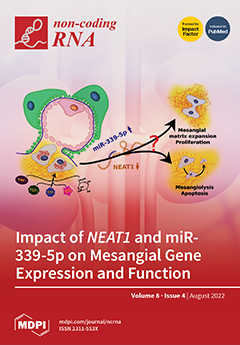Non-coding RNAs reflect many biological processes in the human body, including athero-sclerosis. In a cardiology outpatient department cohort (N = 83), we aimed to compare the levels of circulating microRNAs in groups with vulnerable plaques (N = 22), stable plaques (N = 23)
[...] Read more.
Non-coding RNAs reflect many biological processes in the human body, including athero-sclerosis. In a cardiology outpatient department cohort (N = 83), we aimed to compare the levels of circulating microRNAs in groups with vulnerable plaques (N = 22), stable plaques (N = 23) and plaque-free (N = 17) depending on coronary computed tomography angiography and to evaluate associations of microRNA levels with calculated cardiovascular risks (CVR), based on the SCORE2 (+OP), ACC/AHA, ATP-III and MESA scales. Coronary computed tomography was performed on a 640-slice computed tomography scanner. Relative plasma levels of microRNA were assessed via a real-time polymerase chain reaction. We found significant differences in miR-143-3p levels (
p = 0.0046 in plaque-free vs. vulnerable plaque groups) and miR-181b-5p (
p = 0.0179 in stable vs. vulnerable plaques groups). Analysis of microRNA associations with CVR did not show significant differences for SCORE2 (+OP) and ATPIII scales. MiR-126-5p and miR-150-5p levels were significantly higher (
p < 0.05) in patients with ACC/AHA risk >10% and miR-145-5p had linear relationships with ACC/AHA score (adjusted
p = 0.0164). The relative plasma level of miR-195 was higher (
p < 0.05) in patients with MESA risk > 7.5% and higher (
p < 0.05) in patients with zero coronary calcium index (
p = 0.036). A linear relationship with coronary calcium was observed for miR-126-3p (adjusted
p = 0.0484). A positive correlation with high coronary calcium levels (> 100 Agatson units) was found for miR-181-5p (
p = 0.036). Analyzing the biological pathways of these microRNAs, we suggest that miR-143-3p and miR-181-5p can be potential markers of the atherosclerosis process. Other miRNAs (miR-126-3p, 126-5p, 145-5p, 150-5p, 195-5p) can be considered as potential cardiovascular risk modifiers, but it is necessary to validate our results in a large prospective trial.
Full article






